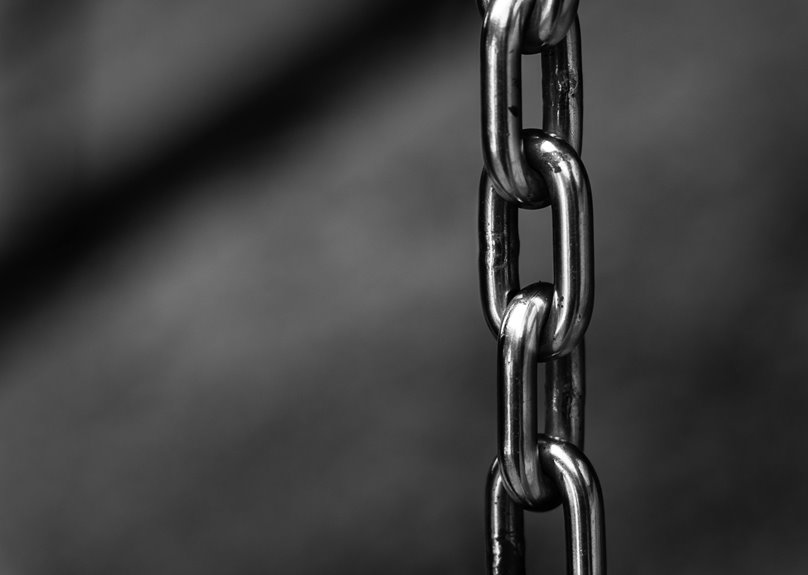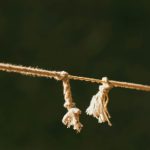You measure Kevlar’s tensile strength by pulling fiber samples until they break using precise machines that track load and stretch. This shows how much force Kevlar can handle before snapping, key to its impact resistance. Factors like fiber alignment and environmental conditions also affect performance. Since Kevlar’s molecular structure and fabric construction influence its ability to absorb energy, understanding these details helps you see why it excels in protective gear and other uses. Exploring deeper reveals how science and testing shape its reliability.
Table of Contents
Key Takeaways
- Kevlar’s tensile strength measures the maximum pulling force before breaking, indicating its ability to resist impact and mechanical stress.
- Universal tensile testing machines pull samples at controlled rates, providing stress-strain data to quantify Kevlar’s impact resistance.
- Kevlar’s molecular structure features tightly aligned polymer chains and strong aromatic bonds that enhance tensile strength and energy absorption.
- Fiber orientation, fabric weave tightness, and environmental exposure significantly affect Kevlar’s impact resistance and durability.
- Real-world testing challenges include sample variability and environmental factors; multiple test methods ensure accurate interpretation of Kevlar’s strength.
Understanding Tensile Strength in Synthetic Fibers
Tensile strength measures how much pulling force a synthetic fiber can handle before breaking. When you evaluate synthetic fibers like Kevlar, understanding this property is essential because it directly relates to durability and resistance under stress.
You’ll find that tensile strength is typically expressed in units like megapascals (MPa), indicating the maximum stress the fiber endures. As you pull on the fiber, you’re testing how it reacts to tension; the higher the tensile strength, the less likely it’s to snap.
This helps you predict performance in real-world applications, such as protective gear or ropes. Knowing tensile strength lets you compare materials objectively, ensuring you pick the right fiber for your needs without guessing about its limits.
The Chemistry Behind Kevlar’s Molecular Structure
You’ll find that Kevlar’s impressive strength comes from its tightly aligned polymer chains.
These chains link together through strong aromatic polyamide bonds, creating a rigid and durable molecular structure.
Understanding this chemistry helps you see why Kevlar resists stretching and breaking under pressure.
Polymer Chain Alignment
Although it might seem complex, understanding polymer chain alignment is key to grasping why Kevlar is so strong. When you look at Kevlar’s structure, you’ll find its long polymer chains are tightly packed and perfectly aligned parallel to each other.
This alignment allows the chains to share the load evenly when force is applied, which dramatically boosts tensile strength. You’ll notice that this arrangement also encourages strong intermolecular interactions, helping Kevlar resist stretching and breaking under stress.
Unlike random or tangled polymers, Kevlar’s ordered chains create a rigid, reinforced framework. So when Kevlar takes an impact, its aligned chains work together to absorb and distribute energy efficiently, making it incredibly tough and resistant to damage.
This precise alignment is a critical factor behind Kevlar’s remarkable durability.
Aromatic Polyamide Bonds
The strength of Kevlar starts at the molecular level with its aromatic polyamide bonds.
You’ll find these bonds form between rigid benzene rings and amide groups, creating a highly stable, linear polymer chain. This unique chemical structure gives Kevlar exceptional tensile strength and thermal stability.
When you apply force, these aromatic rings resist deformation, while the amide bonds provide strong hydrogen bonding between chains. This combination locks the chains tightly together, preventing them from sliding past each other, which is why Kevlar withstands high impact and stress.
Understanding this molecular setup helps you appreciate how Kevlar’s chemistry translates into real-world durability, making it ideal for protective gear and aerospace materials.
In short, these aromatic polyamide bonds are the key to Kevlar’s impressive toughness.
Methods for Testing Kevlar’s Tensile Strength
When you test Kevlar’s tensile strength, you measure how much force the material can withstand before breaking. To do this, you typically use a tensile testing machine that pulls a Kevlar fiber or fabric sample at a constant rate until it snaps. You secure the sample in clamps, apply tension, and record the force and elongation.
Another common method is the use of a universal testing machine (UTM), which provides precise control over load and speed, allowing you to gather stress-strain data. You might also test Kevlar under different conditions, like varied temperatures or humidity, to simulate real-world use.
These testing methods help you understand Kevlar’s durability and guarantee it meets safety and performance standards for protective gear and industrial applications.
Factors Affecting Kevlar’s Impact Resistance
Since impact resistance determines how well Kevlar can absorb and dissipate energy from sudden forces, you need to take into account several key factors that influence this property. The fiber orientation, environmental conditions, and fabric construction all play significant roles. For instance, tightly woven fibers better distribute impact energy, while exposure to moisture or UV light can weaken fibers. Understanding these factors helps you optimize Kevlar’s performance in real-world applications.
| Factor | Description | Impact on Resistance |
|---|---|---|
| Fiber Orientation | Alignment of fibers in material | Better alignment improves energy absorption |
| Environmental | Exposure to moisture, UV, heat | Degrades fiber strength over time |
| Fabric Construction | Weave tightness and layering | Tighter weaves enhance impact resistance |
Comparing Kevlar to Other High-Performance Fibers
Although Kevlar excels in impact resistance and tensile strength, you might wonder how it stacks up against other high-performance fibers like Spectra, Dyneema, or carbon fiber.
Kevlar offers excellent durability and heat resistance, making it a reliable choice for many demanding applications.
Spectra and Dyneema, both ultra-high-molecular-weight polyethylene fibers, actually surpass Kevlar in tensile strength and are lighter, which benefits weight-sensitive uses. However, they’ve lower heat resistance compared to Kevlar.
Carbon fiber, known for its stiffness and strength, outperforms Kevlar in rigidity but lacks flexibility and impact resistance.
Real-World Applications of Kevlar’s Tensile Properties
Because Kevlar combines exceptional tensile strength with lightweight flexibility, you’ll find it in a wide range of real-world applications that demand reliable performance under stress.
When you rely on Kevlar, you get durable protection without added bulk, making it ideal for vital uses.
You’ll encounter Kevlar in:
- Bulletproof vests and body armor, providing life-saving protection
- Aerospace components, where strength-to-weight ratio is essential
- Automotive parts, enhancing safety and structural integrity
- Sporting goods like helmets and racing sails, improving durability
- Industrial gloves and ropes, resisting cuts and abrasions
How Kevlar Absorbs and Distributes Energy
Kevlar’s widespread use in protective gear and high-performance equipment hinges on more than just its strength—it’s how the material handles energy that makes it stand out.
When you face an impact, Kevlar fibers absorb and disperse that energy efficiently, preventing localized damage. The tightly woven fibers stretch slightly, converting kinetic energy into deformation without breaking. This energy distribution spreads the force over a larger area, reducing the chance of penetration or failure.
You’ll notice this in bulletproof vests, where Kevlar stops projectiles by dispersing their energy across the fabric layers. Its unique molecular structure allows it to resist sudden forces, making it ideal for impact resistance.
Understanding this process helps you appreciate why Kevlar remains a top choice for protective applications.
Advances in Kevlar Technology and Manufacturing
As you explore the latest developments in Kevlar technology, you’ll find that innovations in manufacturing processes have significantly enhanced its performance and versatility.
These advances allow you to use Kevlar in more demanding applications with greater confidence. Manufacturers have improved fiber alignment and weaving techniques, boosting tensile strength and durability.
Plus, new resin systems enhance flexibility without sacrificing toughness. You’ll also notice that environmental resistance has improved, making Kevlar more reliable in harsh conditions.
New resin systems boost Kevlar’s flexibility and toughness, enhancing durability in harsh environments.
Here are key advances to keep in mind:
- Precision-controlled fiber spinning
- Nano-enhanced composite integration
- Improved resin impregnation methods
- Customized fiber orientation for specific stresses
- Eco-friendly production techniques
These breakthroughs help you get stronger, lighter, and more adaptable Kevlar products for diverse needs.
Challenges in Measuring and Enhancing Kevlar’s Strength
You’ll find that measuring Kevlar’s strength isn’t straightforward due to testing method limitations that affect accuracy.
At the same time, enhancing its tensile strength requires innovative techniques that push material boundaries.
Let’s explore the challenges you face in both evaluating and improving Kevlar’s performance.
Testing Method Limitations
Although testing Kevlar’s tensile strength might seem straightforward, you’ll quickly find that various factors complicate accurate measurement. The material’s unique weave, fiber alignment, and environmental conditions all influence results.
Plus, no single test captures its full impact resistance. You’ll face limitations like:
- Variability in sample preparation
- Differences in testing machine calibration
- Inconsistent strain rate application
- Challenges simulating real-world stress conditions
- Difficulty measuring multi-axial loading effects
These issues mean your tensile strength values may vary between labs or tests. You should interpret results carefully, knowing they represent approximations rather than absolute values.
This understanding helps you critically assess Kevlar’s performance and guides you in choosing appropriate testing methods without expecting perfect precision.
Strength Improvement Techniques
Understanding the challenges in testing Kevlar’s tensile strength highlights why improving its performance isn’t straightforward.
When you try to enhance Kevlar, you face difficulties like ensuring uniform fiber alignment and avoiding defects during manufacturing. Even small inconsistencies can weaken the material’s strength.
You also have to balance improving tensile strength with maintaining flexibility and impact resistance. Techniques like blending Kevlar with other fibers or applying surface treatments can boost strength, but measuring these improvements accurately remains tough.
Testing methods may not capture subtle changes, so you have to interpret results carefully. To get better performance, you’ll often need to experiment with processing conditions and fiber structures while constantly verifying outcomes.
This trial-and-error process requires patience and precise testing to push Kevlar’s limits effectively.
Frequently Asked Questions
Can Kevlar Be Recycled After Use?
Recycling Kevlar isn’t a walk in the park; you can’t just toss it in the bin. But you can recycle it through specialized processes, turning old fibers into new materials, helping you reduce waste and support sustainability.
How Does Moisture Affect Kevlar’S Durability?
Moisture can weaken Kevlar’s fibers, reducing its durability over time. You’ll notice it absorbs some water, which may cause slight swelling and decreased strength. Keeping it dry helps maintain its protective qualities longer.
What Are the Environmental Impacts of Kevlar Production?
When you think of Kevlar, imagine a shield born from nature’s hidden cost. Its production releases toxic chemicals and consumes lots of energy, impacting ecosystems and communities. You can choose sustainable alternatives to lessen this burden.
Is Kevlar Safe for Prolonged Skin Contact?
Kevlar is generally safe for prolonged skin contact, but you might experience irritation or itching if you’re sensitive. Wearing a liner or proper clothing can help prevent discomfort during extended use.
How Does Kevlar Perform Under Extreme Temperatures?
Like a seasoned warrior, Kevlar holds strong even under extreme temperatures. You’ll find it resists heat up to about 800°F and remains stable in cold, making it reliable when conditions get tough or icy cold.
- How to Source Aramid Fabric by the Yard From China - June 22, 2025
- Decoding Aramid Fabric Specs: 1500D, 8oz, and More - June 22, 2025
- The Science of Aramid Based Armor Fabric - June 22, 2025







